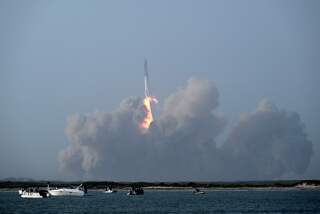Watch SpaceX’s rocket soar half a mile above Earth and return
SpaceX launched its reusable 10-story Grasshopper rocket more than 2,440 feet in a flight to test technologies needed to one day return a rocket back to Earth intact.
During the flight, the rocket blasted off, hovered and landed safely on the launch pad. At its top altitude, the rocket flew twice the height of the U.S. Bank Tower, the tallest building in Los Angeles.
SpaceX, the Hawthorne company that builds rockets and space capsules to resupply the International Space Station for NASA, is aiming to develop a rocket that can return to a launch pad for a vertical landing, instead of burning up as it reenters Earth’s atmosphere.
A reusable system could mean big savings in developing and operating rockets. The closest example of a reusable system is the retired space shuttle fleet, but they were spacecraft that were only partially reused after a tedious months-long overhaul.
PHOTOS: Elon Musk’s high-tech empire
The Oct. 7 SpaceX test, which was posted on YouTube over the weekend, was a big step toward achieving that goal.
Video of the test can be seen above. SpaceX used a small drone to record the flight, which captured all the images from above.
The test at the company’s facilities in McGregor, Texas, lasted 97 seconds.
For months, the company has been conducting a series of successful low-altitude tests of the Grasshopper in Texas. It plans to move testing to a commercial spaceport New Mexico at a later date.
Founded in 2002, SpaceX makes its cargo capsules and rockets at its sprawling facility in Hawthorne, which was once used to assemble fuselage sections for Boeing Co. 747s.
The company, formally known as Space Exploration Technologies Corp., has successfully carried out two cargo resupply missions to the International Space Station.
It was founded by Los Angeles billionaire Elon Musk, who earlier this year laid out plans for his Hyperloop transportation system to much fanfare. The proposed system aims to take travelers from Los Angeles to San Francisco in 35 minutes.
ALSO:
Boeing to shut C-17 plant in Long Beach
Forest Service fights fires with aging tankers from another era
Watch Orbital Sciences launch capsule to International Space Station
More to Read
Inside the business of entertainment
The Wide Shot brings you news, analysis and insights on everything from streaming wars to production — and what it all means for the future.
You may occasionally receive promotional content from the Los Angeles Times.










